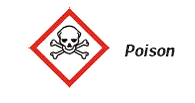Four categories of hazards commonly found in school settings (science labs in particular) are: corrosives, flammables, oxidizers/reactives, and toxins.
Corrosives:

Corrosives are materials that can injure body tissue or cause corrosion of metal by direct chemical action. Major classes of corrosive substances are:
- strong acids (e.g., sulfuric, nitric, hydrochloric and hydrofluoric acids)
- strong bases (e.g., sodium hydroxide and potassium hydroxide)
- dehydrating agents (e.g., sulfuric acid, sodium hydroxide, phosphorus pentoxide, and calcium oxide)
- oxidizing agents (e.g., hydrogen peroxide, chlorine, and bromine)
Flammables:

Flammable substances have the potential to catch fire readily and burn in air. A flammable liquid itself does not catch fire; it is the vapors produced by the liquid that burn. Important properties of flammable liquids:
- Flash point is the minimum temperature of a liquid at which sufficient vapor is given off to form an ignitable mixture with air.
- Ignition temperature is the minimum temperature required to initiate self-sustained combustion independent of a heat source.
Oxidizers/Reactives:

Oxidizers/reactives include chemicals that can explode, violently polymerize, form explosive peroxides, or react violently with water or atmospheric oxygen.
- Oxidizers: An oxidizing agent is any material that initiates or promotes combustion in other materials, either by causing fire itself or by releasing oxygen or other combustible gases.
- Reactives: Reactives include materials that are pyrophoric (“flammable solids”), are water reactive, form explosive peroxides, or may undergo such reactions as violent polymerization.
Toxins:

A toxic substance is one that, even in small amounts, can injure living tissue.
- Irritants are noncorrosive chemicals that cause reversible inflammatory effects (swelling and redness) on living tissue by chemical action at the site of contact. Because a wide variety of organic and inorganic chemicals are irritants, skin and eye contact with all chemicals in the laboratory should be avoided.
- Corrosive substances are solids, liquids, and gases that cause destruction of living tissue by chemical action at the site of contact.
- Allergens are substances which cause an adverse reaction by the immune system. As these reactions result from previous sensitization from the substance or similar substance, chemical allergens will be different for each person.
- Asphyxiants are substances that interfere with the transport of an adequate supply of oxygen to the vital organs of the body. They can do this by either displacing oxygen from the air or by combining with hemoglobin and thus reducing the blood’s ability to transport oxygen.
- Carcinogens are cancer-causing substances listed in the Annual Report on Carcinogens. Many substances known or suspected to be carcinogenic are still found to be in high school laboratories. There is little reason for most of them to be there; they should be disposed of as quickly as possible.
- Reproductive & developmental toxins (teratogens and mutagens) either have an adverse effect on the various aspects of reproduction (fertility, gestation, lactation and general reproductive performance) or act during pregnancy to cause adverse effects on the embryo or fetus.
- Neurotoxins induce an adverse effect on the structure or function of the central and/or peripheral nervous system. These effects can be permanent or reversible.
- Toxins affecting other organs can also be a hazard. Most of the chlorinated hydrocarbons and aromatic compounds, some metals, carbon monoxide, cyanides, and others can produce one or more effects on target organs in the body.
The following website offers more information on this topic:http://www.nfpa.org National Fire Protection Association.
Source: Chemicals: Managing, Handling and Disposing, School Improvement in Marylandhttp://www.mdk12.org/instruction/curriculum/science/safety/chemicals.html
What defines hazardous waste?
A hazardous waste is a solid, liquid or gas that could pose dangers to human health or the environment. Several federal, state and local agencies may regulate a laboratory’s hazardous materials and wastes. These include the federal Environmental Protection Agency, the Utah Department of Environmental Quality, the local fire department, the local air quality authority and the local sewer district. Not complying with hazardous waste regulations can lead to significant fines and penalties. It is important that laboratory managers take steps to avoid violating regulatory requirements.
King County, Washington Local Hazardous Waste Management Program – Hazardous Chemicals in Schools Database: http://www.lhwmp.org/home/educators/chemlist.aspx